Over 40,000 Miles, the 2019 Honda Ridgeline Proves It's a Real Truck
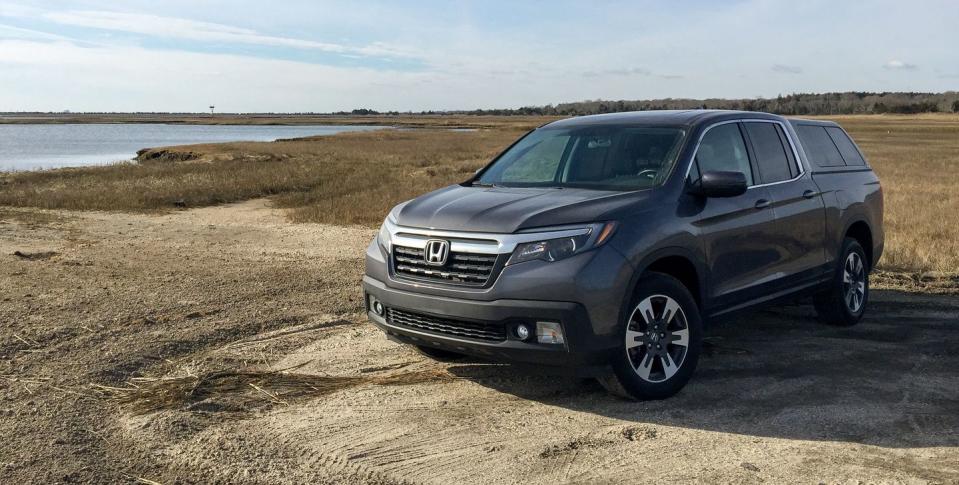
40,000-Mile Wrap-Up
Just over a year and 40,000 miles ago, we welcomed a 2019 Honda Ridgeline into our fleet with the clearsighted goal of proving its worth as a pickup truck. Like every other vehicle we put through our long-term-test regimen, the Ridgeline would be used for hauling our families on trips both short and lengthy. By virtue of its cargo bed and trailer hitch, it would also be pressed into trucky service, lugging and tugging stuff of all sorts. The Ridgeline did that and more, and it did those things generally quite well.
Scour the comments on this very page, as well as chat with some traditional truck buyers, and it won't take long for someone to bring up how the Ridgeline is something of a wimp in the greater truck world. The uncommon vitriol aimed at the second-generation Honda pickup has everything to do with its being the only player in the mid-size class with a carlike unibody instead of a conventional body-on-frame construction.
Empirically, yes, the Ridgeline has a lower towing capacity than body-on-frame mid-size trucks. But that's pretty much the only performance metric in which it cedes ground to the competition. And during our truck's 40,000 miles, we never encountered a towing task it couldn't handle. To be fair, none of our staffers regularly attempts to pull more than the Honda's 5000-pound towing capacity. If you have a modest-sized boat or a race car that you'd like to trailer from place to place, the Honda has your back. It's fazed only by the aerodynamic drag of taller, bulkier (but not necessarily heavier) trailers, and even then, the Ridgeline stands up to the job—it simply has to work a little harder.
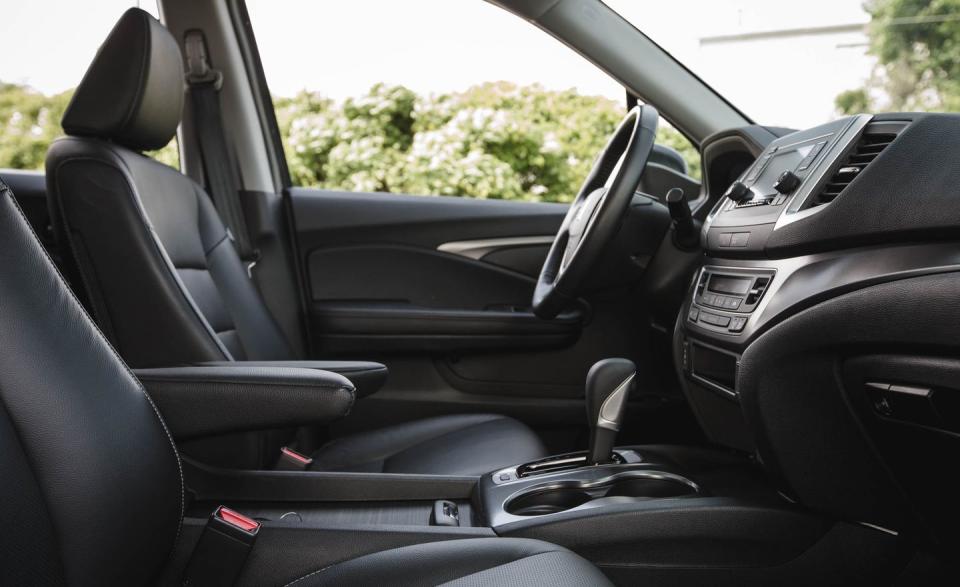
"What a great truck (and, yes, it's a truck, to all the haters out there). It's seriously practical without being unparkably huge."
Mid-size trucks are supposed to be more everyday friendly than today's gargantuan full-size pickups. Placed in that context, rather than in comparison with burlier mid-size trucks that can tow 7000 pounds or more (reaching for full-size territory), the Honda is class leading. As vehicle testing director Dave VanderWerp put it: "What a great truck (and, yes, it's a truck, to all the haters out there). It's seriously practical without being unparkably huge."
Throughout the Ridgeline's stay, our staffers repeatedly praised its segment-best ride and handling, both of which are direct results of the unibody construction, which allows for the class-exclusive independent rear suspension and a relatively light curb weight. Nothing can touch the Honda's refinement, not the new Ford Ranger, nor Toyota's Tacoma, Chevrolet's Colorado, or GMC's Canyon. The fancy suspension—by pickup standards—seemingly had no effect on the Ridgeline's towing and hauling capabilities. After fully loading the Honda's back seat and bed with a workshop's worth of tools in New Jersey and nosing the Ridgeline west toward our Ann Arbor, Michigan, headquarters, technical assistant Harry Granito remarked, "The return trip with the extra weight of the equipment felt the same as the trip out empty."
Given how the pickup-truck playbook typically calls for stiff rear springs to handle heavy loads, which can result in a firm, bouncy ride when the truck is empty, the Ridgeline's deft management of weighty cargo while delivering a cushy ride is noteworthy. Even while towing the maximum weight limit, the Ridgeline's rear suspension never unduly sagged or felt overburdened. Staff photographer Michael Simari, who used the Honda to drag his Acura Integra track car across Michigan to GingerMan Raceway, extolled "how great the ride is on long hauls, compared to what others call a 'real truck.'"
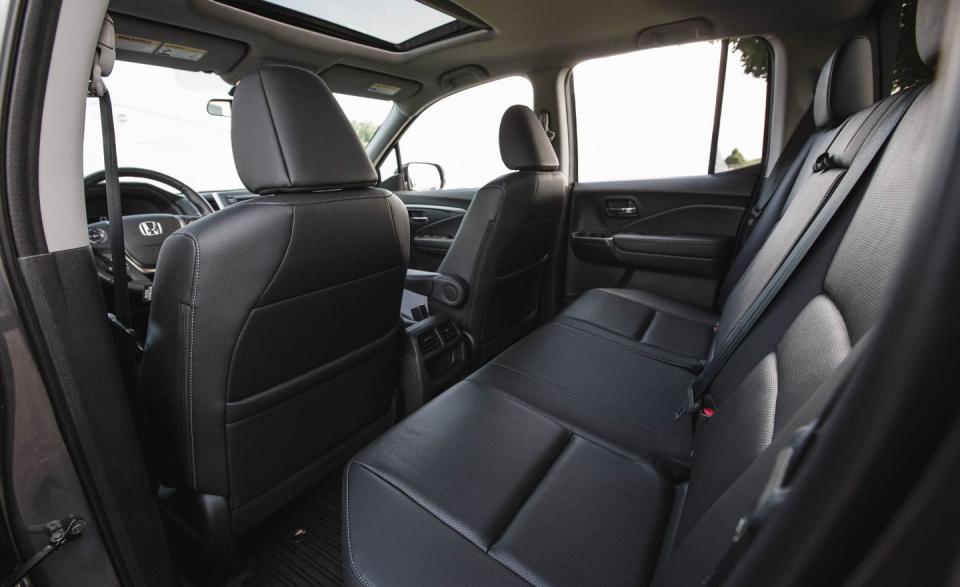
While pickups in general are useful, practical, and ready for nearly any rough-and-tumble task, the Honda is particularly so. It has numerous standout features that can't be found on any competitor. Without a beefy frame in the way, the Ridgeline offers a roomy, well-packaged interior with space for five, as well as a weather-resistant seven-cubic-foot trunk in the floor of the pickup bed. On several occasions, we used that trunk as a gigantic cooler (a drain plug in its floor lets water out). You can also toss dirty camping gear in that clever, lockable hold, including an entire (badly folded) tent—hey, flash rainstorms happen.
Speaking of, we bought the nifty tent from Honda's accessories catalog that's designed to fit in the Ridgeline's bed (with the tailgate lowered) and spacious enough for an air mattress and two adults. Zippered panels in the tent's floor allow access to the underbed trunk and the in-bed AC electrical outlet on Ridgelines so equipped (our RTL-spec Ridgeline lacked this feature). Let your overlanding fantasies run wild. For those who want to set up camp but still drive their Ridgelines, we found that you can unclip the tent from the bed sides, lift it out (fully assembled), and set it on the ground. Simply place the tent back into the bed and clip it down when you return to camp.
Complaints about the Ridgeline throughout its 40,000-mile stay were few. An aftermarket bed cap we placed on the truck drew endless hate from most staffers (although a few appreciated the weathertight cargo hold it created during the winter months). Problems everyone agreed on were soggy brake-pedal feel and the base radio head unit, which proved difficult to pair with a Bluetooth device (a touchscreen system with its own usability issues is available). Inasmuch as we believe the Ridgeline to be a real truck, most of our staffers—and other observers—felt it could do more to look the part. As it sits, the Honda's reserved styling too closely resembles that of the inoffensive Pilot SUV with which the Ridgeline shares some mechanicals.
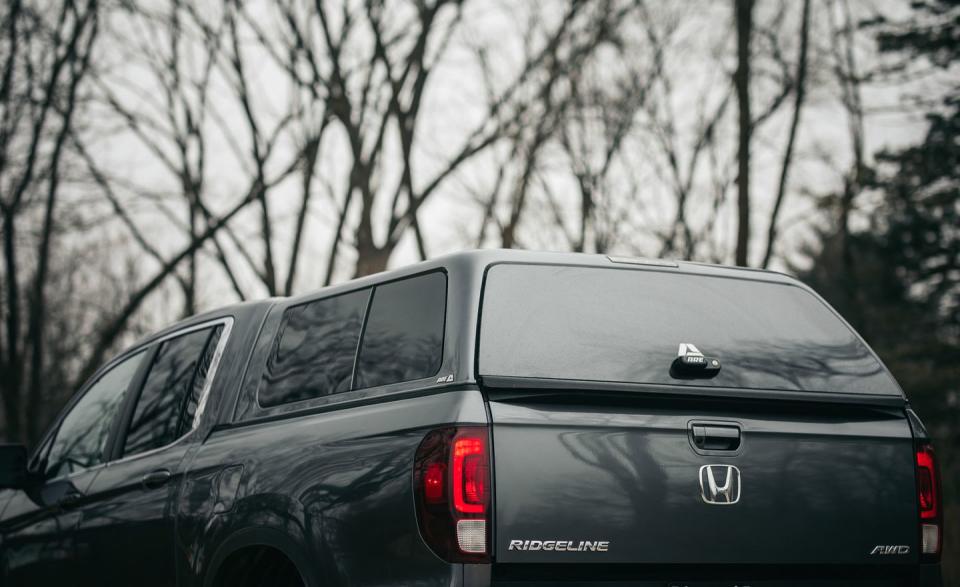
We recorded 18.1 mpg over 516 mostly highway miles while towing a roughly 4000-pound load.
Fuel economy proved a high point, as expected: The Honda averaged 20 mpg during its 40,000 miles with us. That figure is 1 mpg shy of the EPA combined fuel-economy estimate and 2 mpg higher than the Ridgeline's 18-mpg city rating. That the Honda pulled off such efficiency at the beck and call of our heavy-footed towing and hauling excursions is a testament to its slippery aerodynamics and relatively lightweight unibody construction. Several drivers reported strong fuel economy even while towing a trailer, with Buyer's Guide assistant editor Eric Stafford recording 18.1 mpg over 516 mostly highway miles while towing a roughly 4000-pound load.
Service costs proved somewhat high, at $764, split among four service visits called for by the Ridgeline's onboard computer—our most recent long-term pickup truck, a 2017 Ford F-150 Raptor, required only $531 in service over the same mileage. And our dissatisfaction with the Honda's squishy brake pedal wasn't helped by needing to resurface the brake rotors at around 38,000 miles at a cost of $494.
That said, the Ridgeline's braking performance from 70 mph actually improved by 15 feet when we tested it again at 40,000 miles. It also picked up 0.04 g of lateral grip on the skidpad. Both improvements can be largely chalked up to slightly worn tires; shortened, used-up tread blocks tend to improve dry grip. Acceleration from the broken-in engine also perked up, with the trip from zero to 60 mph taking only 6.5 seconds, a 0.4-second improvement from when the Honda was new. In every metric, the Ridgeline is a top performer among mid-size pickups—more so when judged subjectively. It remains a smart buy for truck shoppers looking for a right-sized, capable, everyday comfortable, efficient pickup. And, yes, it's a real damn truck.
Months in Fleet: 13 months Current Mileage: 40,027 miles
Average Fuel Economy: 20 mpg
Fuel-Tank Size: 19.5 gal Observed Fuel Range: 390 miles
Service: $764 Normal Wear: $15 Repair: $494
Damage and Destruction: $3541
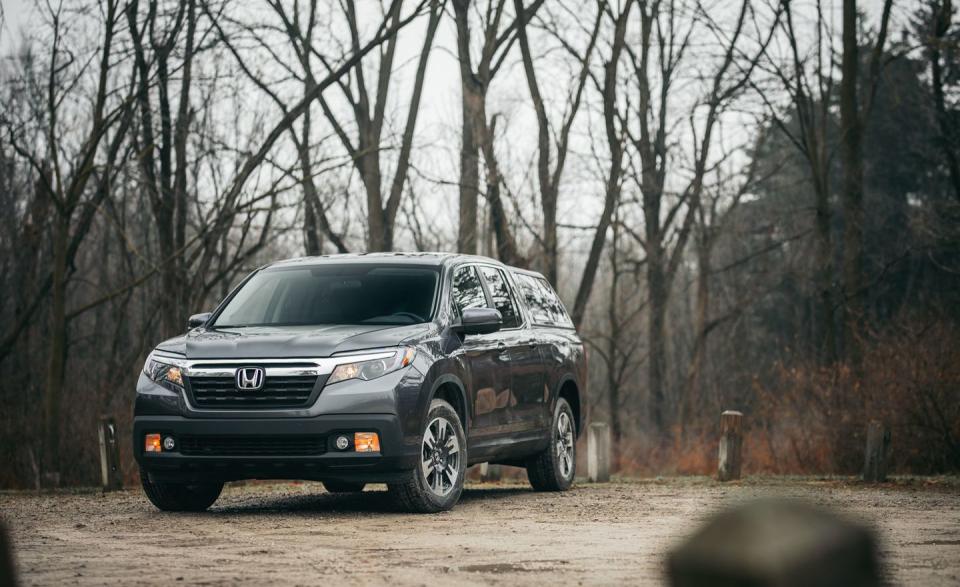
30,000-Mile Update
With less than 5000 miles to go in its 40,000-mile sentence, we've amassed plenty of reasons to like our 2019 Honda Ridgeline—and not solely because, at least for the past few months, it has been the only pickup truck in our long-term fleet. While negative comments continue to pour into the Ridgeline's logbook regarding its aftermarket ARE bed cap, they can be readily dismissed as the collective hatred of people who didn't want it in the first place.
Imagine, for a moment, that you're a truck owner who purchased this bed cap knowing full well you were giving up the freedom to load a snowmobile, motorcycle, or some other large doohickey that would be relatively easy to transport in an open pickup bed. Suddenly, it isn't so bad, particularly in nasty winter weather. The cap's paint nicely matches our Honda's hue and provides dry storage for goods in a space taller than what you'd get beneath a sealed tonneau cover, a convenience that several staffers took advantage of to move smaller stuff across Michigan's wintry landscapes. If that sounds appealing, buy the cap; if not, don't. While the cap severely reduces rear visibility (the darkly tinted glass doesn't help) and has an unavoidable straight-line roof that doesn't quite match up with the Ridgeline's domed cab, those drawbacks are offset by its positives, provided you're open to them. In brief, it's not the cap's fault, and we're sure it will seek counseling as soon as it's stripped from our truck at the end of this evaluation.
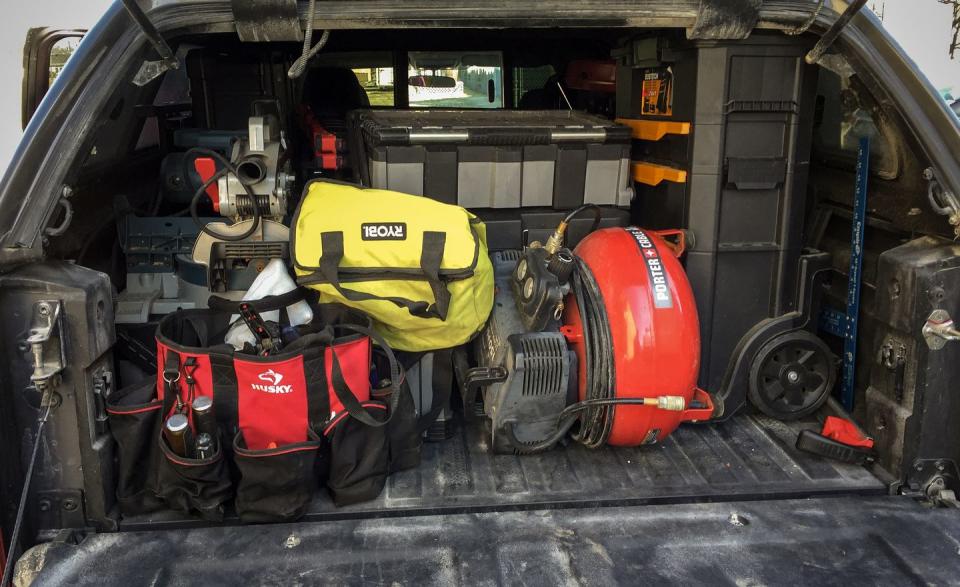
Although some of our drivers who are predisposed to burlier pickups think the Ridgeline isn't a strong towing implement, others have successfully yanked loads up to the Honda's tow rating without issues. As we've covered in past updates, trailer height plays a big role: anything taller than the Ridgeline itself creates enough aerodynamic drag to give the Honda a workout. Lower-profile trailers and cargo, even heavy ones, are easily tugged without problem. However, some complaints have come in for the brake pedal's long stroke and the binders' lack of initial bite. This was an issue also we noted in our long-term test of the Honda Odyssey minivan, the Ridgeline's platform-mate, and the pedal feel and impression of weak braking power lessen driver confidence when slicing in and out of traffic, especially when towing.
The Ridgeline itself has been a relatively smooth operator since our last update. Routine service at 26,628 miles cost $163 and included an oil and filter change, new cabin and engine air filters, and a tire rotation. And, at 34,715 miles, a recall notice prompted us to have the dealer inspect the Honda's fuel pump for cracks or leaks under warranty. The dealer found nothing amiss and, as a precaution, fitted a cover over the fuel pump and fuel line. The Honda's general reliability and agreeableness have been a boon to its mileage accumulation, which, over the past 10,000 or so miles, has been accelerated by voyages to Vermont, New Jersey, Indiana, and a pair of treks to northern Michigan with a trailer full of snow machines in tow—and some of those excursions, such as the New Jersey run with the Ridgeline loaded with a garage's worth of tools, were actually made better by the presence of the bed cap.
Months in Fleet: 11 months Current Mileage: 35,536 miles
Average Fuel Economy: 20 mpg
Fuel Tank Size: 19.5 gal Observed Fuel Range: 390 miles
Service: $587 Normal Wear: $15 Repair: $0
Damage and Destruction: $3541
20,000-Mile Update
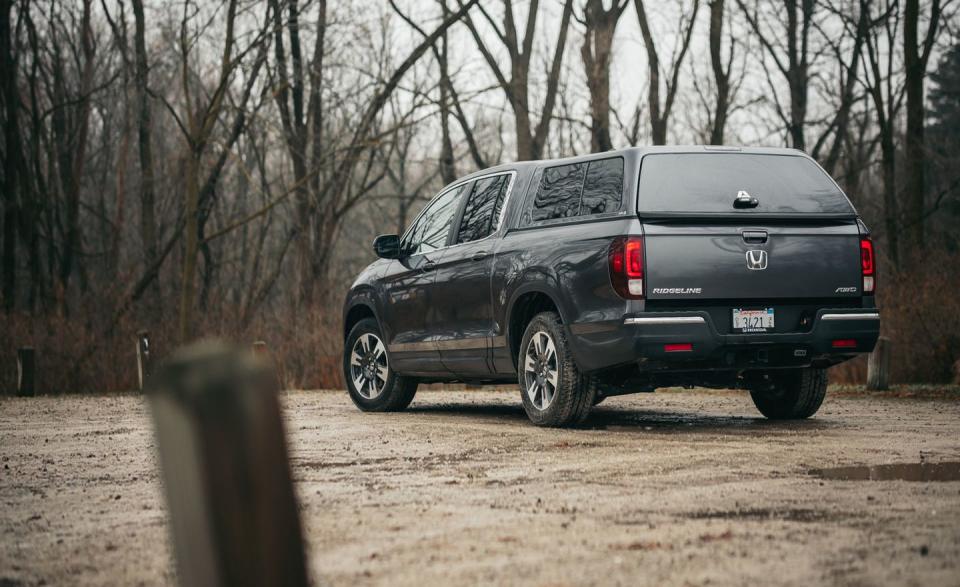
WHAT WE LIKE: The truck's versatility. We've used the Honda Ridgeline to camp, tow, haul stuff, and commute, enjoying it equally no matter the task. Praise continues to roll in for the Ridgeline's un-pickup-truck-like smooth and secure ride and handling as well as for its numerous interior storage cubbies, flexible rear-seat folding options, and the handy weatherproof trunk hidden beneath the pickup bed's floor. Mileage accumulation has continued to be strong, barring a few stints on the disabled list related to a repair—more on that below.
WHAT WE DON’T LIKE: Since our last report on the Ridgeline, we have affixed a bed cap to its tail. This probably should have been put to a wider vote before happening, because the non-factory cap has garnered largely negative reviews. On one hand, the cap keeps anything placed in the bed dry and sheltered; on the other hand, it severely limits what can fit back there, and many dissenters have complained that they weren't able to move tall furniture or bulky items. Visibility to the rear also is greatly compromised. We're leaving the cap on for now for two reasons: It's difficult to remove, having been sealed against the top of the bed sides, and winter is upon us, so the additional dry storage is welcome.

As for issues attributable to the Ridgeline itself, there are few. The lower-spec radio head unit that came with our RTL trim was initially viewed as preferable to the uplevel touchscreen on fancier models but has since lost advocates. In spite of its easy-to-use volume and tuning knobs—and preset buttons!—the non-touch unit looks old, and performing tasks such as pairing a Bluetooth device are harder than they should be. Some drivers have complained that low-speed shift quality from the six-speed automatic transmission can be balky.
WHAT WENT WRONG: The Ridgeline was hit from behind while returning south from Michigan's Upper Peninsula. An inattentive driver slammed into the Ridgeline as traffic ahead on Michigan's I-75 freeway slowed to gawk at a pair of military helicopters strafing the highway (why the choppers were doing this, we'll never know). The other car, driver hunched over his steering wheel and peering up through his windshield at the Blackhawk helicopters above, hit the Honda—which was slowing through 60 mph—at about 80 mph.

The responding Michigan State patrolman was impressed by the Ridgeline's lack of damage compared to the Pontiac G6 that hit us—the sedan's engine was wearing its pummeled radiator like a form-fitting cocktail dress. Having barfed its coolant, the Pontiac let out a death rattle and joined GM's excitement division in that great automotive graveyard in the sky. Thankfully, nobody was seriously hurt, and the Ridgeline was able to continue on its journey to Ann Arbor.
Back home, the body shop assuaged our initial fears that the unibody had been tweaked (since the other car went partly underneath the Ridgeline's tail). Repairs were confined to the rear bumper and some trim; the shop also melted shut a crack in the plastic lining of the trunk beneath the Ridgeline's bed floor. The right-side doors and fenders also required a light repaint because we clipped a metal roadside reflector when dodging another car after the initial impact. Final damage bill: $3541.

 Yahoo Autos
Yahoo Autos 